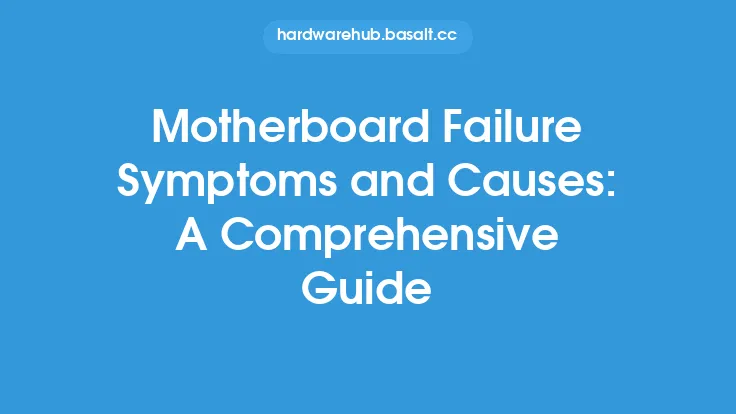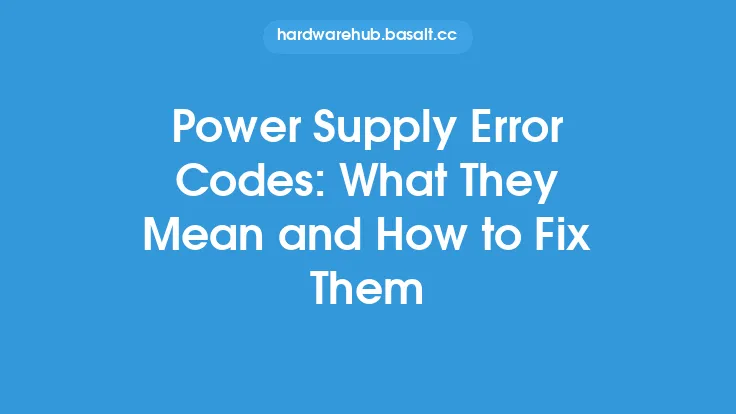When a computer is powered on, the motherboard performs a series of diagnostic tests to ensure that all components are functioning properly. If any issues are detected, the motherboard will often produce a series of beep codes or display error messages to indicate the nature of the problem. These beep codes and error messages are an essential diagnostic tool for troubleshooting motherboard issues, and understanding their meanings can help users identify and resolve problems quickly.
Introduction to Beep Codes
Beep codes are a series of audible beeps that a motherboard produces when it encounters a problem during the boot process. The pattern and number of beeps can vary depending on the motherboard manufacturer and model, but they generally follow a standard format. The most common beep code patterns are:
- A single beep, indicating that the motherboard has completed its diagnostic tests and is ready to boot the operating system.
- A series of beeps, indicating a problem with the system's memory, CPU, or other components.
- A continuous beep, indicating a critical error that prevents the system from booting.
Common Beep Code Patterns
Different motherboard manufacturers use different beep code patterns to indicate specific problems. Some common beep code patterns include:
- 1-1-1-1 (four beeps): This pattern typically indicates a problem with the system's memory.
- 1-2-2-1 (four beeps): This pattern may indicate a problem with the CPU or motherboard chipset.
- 1-3-3-1 (four beeps): This pattern can indicate a problem with the system's graphics card or display.
- Continuous beeping: This pattern usually indicates a critical error, such as a failed CPU or motherboard.
Error Messages
In addition to beep codes, motherboards may also display error messages on the screen to indicate specific problems. These error messages can be more detailed than beep codes and often provide a clear indication of the issue. Some common error messages include:
- "Memory not detected": This message indicates that the motherboard is unable to detect the system's memory.
- "CPU not detected": This message indicates that the motherboard is unable to detect the CPU.
- "Graphics card not detected": This message indicates that the motherboard is unable to detect the graphics card.
- "Boot device not found": This message indicates that the motherboard is unable to find a bootable device, such as a hard drive or SSD.
Troubleshooting Beep Codes and Error Messages
To troubleshoot beep codes and error messages, users should follow a systematic approach:
- Consult the motherboard manual: The first step is to consult the motherboard manual to determine the meaning of the beep code or error message.
- Check the system's hardware: Verify that all hardware components, such as the CPU, memory, and graphics card, are properly installed and seated.
- Run diagnostic tests: Run diagnostic tests, such as a memory test or CPU stress test, to identify any issues with the system's hardware.
- Check for loose connections: Verify that all cables and connections are secure and not loose.
- Reset the BIOS: Reset the BIOS to its default settings to ensure that any changes made to the BIOS are not causing the issue.
- Update the BIOS: Update the BIOS to the latest version to ensure that any bugs or issues are resolved.
Advanced Troubleshooting Techniques
For more complex issues, users may need to employ advanced troubleshooting techniques, such as:
- Using a POST card: A POST (Power-On Self-Test) card is a diagnostic tool that can be installed in a PCI slot to provide detailed information about the system's boot process.
- Using a multimeter: A multimeter can be used to measure the voltage and current of the system's power supply to ensure that it is functioning properly.
- Using a logic analyzer: A logic analyzer can be used to capture and analyze the system's debug output to identify any issues with the motherboard or its components.
Conclusion
Beep codes and error messages are essential diagnostic tools for troubleshooting motherboard issues. By understanding the meanings of these codes and messages, users can quickly identify and resolve problems, reducing downtime and increasing productivity. Whether you're a beginner or an experienced technician, being able to troubleshoot beep codes and error messages is a valuable skill that can help you diagnose and repair a wide range of motherboard issues.





